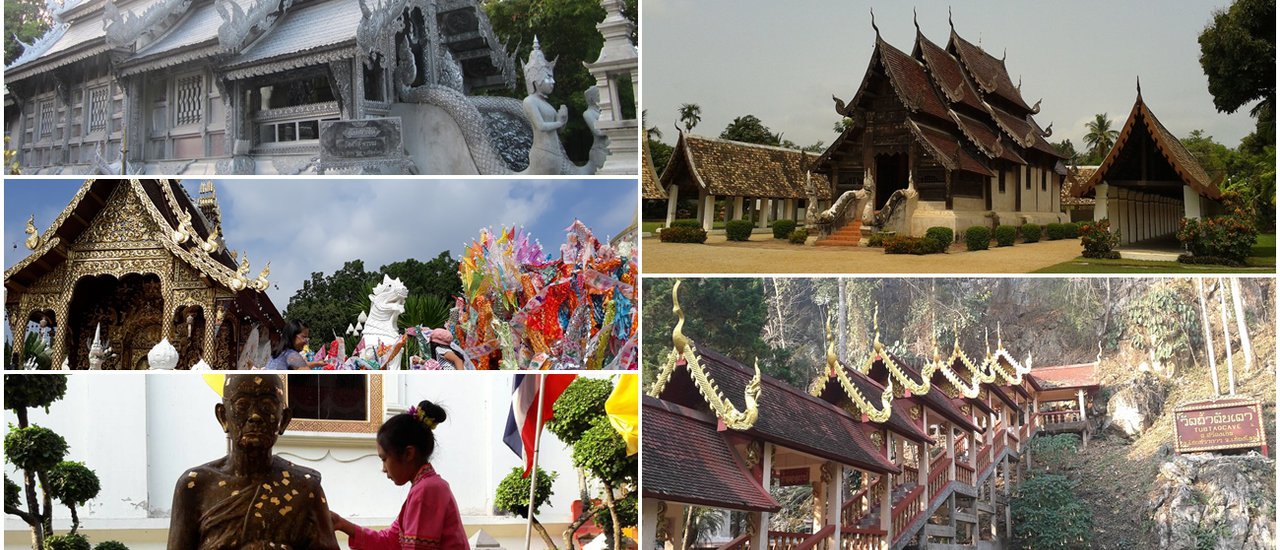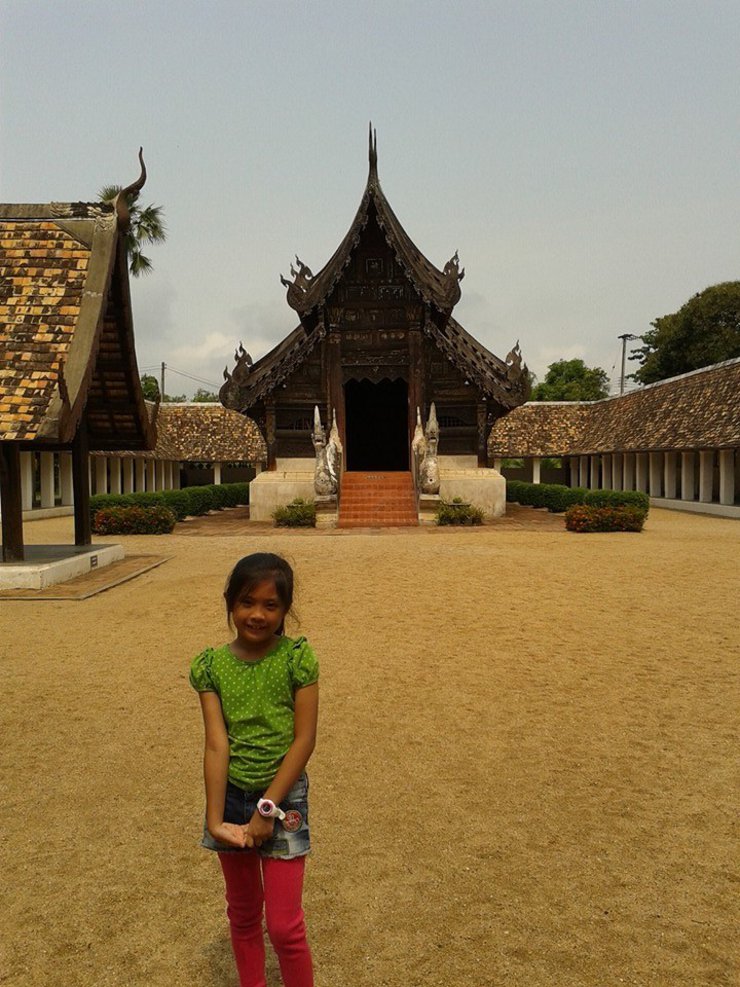Chiang Mai, the Rose of the North, is renowned for its abundance of stunning temples. Today, we will embark on a journey to explore five of these magnificent structures.
Wat Ton Kwen (Wat Intrawas): A Gem of Lanna Architecture
Wat Ton Kwen (Wat Intrawas), a magnificent ancient temple constructed between 1856 and 1869, stands as a testament to the exquisite artistry of Lanna architecture. Situated in Soi 3, Nong Khwai Subdistrict, Hang Dong District, Chiang Mai Province (near the Royal Flora Ratchaphruek Park), this temple was once a resting place for the elephant and horse processions accompanying the sacred Sri Chom Thong Chedi from Chom Thong District to Chiang Mai, allowing the public to bathe the relic.
Renowned for its breathtaking beauty, Wat Ton Kwen served as a filming location for the popular historical drama "Ruk Nakorn." The temple's intricate carvings, graceful structures, and serene atmosphere transport visitors to a bygone era, showcasing the cultural richness and artistic brilliance of the Lanna Kingdom.

The Sala Chaturmuk, found only in the northern region of Thailand, is a complete and highly valuable example of traditional Lanna art and architecture. The Association of Siamese Architects declared it an outstanding heritage building in 1989. Wat Ton Kwen has served as inspiration for architects who used it as a model for the design of Ho Kham Luang, located in the center of Rajapruek Royal Park. This temple has often been used as a filming location for historical dramas that reflect the traditional Lanna culture, most recently in the drama series "Plerng Prang."

The 'Makara-Naga' Staircase, Left and Right
Note: The original text only mentions the left and right sides of the staircase, but does not provide any further information about them.

The architectural structure and components of the temple will utilize carved wood.

The temple's architect demonstrated exceptional skill and expertise in carving, as evidenced by the intricate floral patterns, animal figures on the gable, and the finial. The base of the altar features sculpted lotus flower motifs.

The principal Buddha image in the wooden viharn.

The enigmatic stucco motif of a mermaid devouring a naga.

The name of the temple, Wat Ton Kwen, originates from the Ton Kwen tree, which is located near the temple wall.

The chained Rahu embracing the moon at the temple gate represents a Lanna belief that it protects and defends the temple and its inhabitants from danger.


Wat Sri Suphan is an ancient temple in Chiang Mai, Thailand, built in 1400 AD. Located on Wua Lai Road, it is situated in the renowned silverwork district of Chiang Mai. In 2007, the "Lanna Silapattana Center for the Study of Ancient Thai Art at Wat Sri Suphan" was established to preserve the community's intellectual heritage for future generations.
Silver Ubosot of Wat Sri Suphan was built by local people to promote Buddhism, conserve and develop local wisdom, and silverware handicrafts. The interior and exterior are decorated with silverware handicrafts, making it the first silver Ubosot in the world. It is a masterpiece of Buddhist art and an Unseen highlight of Chiang Mai province.

The principal Buddha image in the Silver Ubosot, known as Phra Phuttha Patimakorn (Phra Chao Chet Tu), is said to possess miraculous powers.

A Ganesha statue, measuring 1.25 meters wide and 1.50 meters tall, stands in front of the Ho Trai library. The statue, adorned in Lanna-style regalia, serves as a symbol of good fortune for the ten groups of artisans.

Wat Phra Singh Woramahawihan, a first-class royal temple, was built in 1888. Located on Sam Lan Road, Phra Singh Subdistrict, Mueang District, Chiang Mai Province, it is a significant temple housing Phra Singh (Phra Phuttha Sihing), a sacred Buddha image of Chiang Mai and the Lanna Kingdom. The Buddha image is in the Chiang Saen art style and is known as "Chiang Saen Singh One." Wat Phra Singh boasts beautiful Lanna architecture, making it well-known and familiar to tourists.


The Exquisitely Ornamented Wihan Lai Kham
The Wihan Lai Kham, adorned with intricate and meticulously crafted stucco patterns, stands as a testament to the unparalleled artistry of its era. Built in the architectural style of northern Thailand, the wihan features two serpent statues flanking the entrance staircase and two lion statues nearby. Inside, the revered "Phra Phuttha Sihing" Buddha image, deeply respected by the Lanna people, resides.





English:
Note:
The original text is empty, so the translation is also empty.

During the Songkran Festival, or the annual Pi Mai Mueang tradition, the **"Phra Phuttha Sihing"** is invited to participate. This ancient Buddha statue, cast in bronze and covered in gold in the Lanna style, depicts the Buddha in the Mara-Vijaya posture with legs crossed in the diamond position. The statue is placed on a beautifully decorated chariot and paraded around the city, allowing devotees to participate in the ritual of pouring water over the statue as part of the New Year celebrations, according to Lanna beliefs.


The Daranee Ram Temple
The Daranee Ram Temple, located in Rim Tai Subdistrict, Mae Rim District, Chiang Mai Province (behind the district office), was established as a temple in 1938. It was granted the status of a third-class royal temple by royal decree, making it the seventh royal temple in Chiang Mai Province. The temple's name is derived from the name of Princess Daranee Rasmi, the Royal Consort. The temple is renowned for its beautiful Lanna-style architecture.
The Royal Vihara was built to commemorate the temple's elevation to the status of a royal monastery in 1999 and to honor the Queen Consort Saovabha Phongsri of King Chulalongkorn. It is a Lanna-style building modeled after the ancient Haw Kham of the Chiang Mai rulers.


The Supreme Dharma King, the Sovereign of the Wheel of Dharma
This sentence describes the main Buddha statue on the Ho Kham Royal Chapel, which is referred to as "The Supreme Dharma King, the Sovereign of the Wheel of Dharma." This title emphasizes the Buddha's role as the ultimate spiritual leader and teacher, who set in motion the "Wheel of Dharma" – the teachings that lead to enlightenment.

The side entrance to the main temple.

The surrounding atmosphere is beautifully shaded.

Shorea robusta

The Phra Chulamanee Sri Borommathat Pavilion (Glass Palace), constructed to enshrine the sacred tooth relic, is a square pavilion with a side length of 21 meters and a height of 4 stories. It features four tiers of overlapping roofs and a golden-plated stupa-like spire adorned with gold leaf. The pavilion, reaching a height of 39 meters from base to the top of the umbrella, showcases a blend of Lanna Thai and Tai Yai architectural styles.

The architectural design of the building is based on the Buddhist cosmology, with the central pavilion representing Mount Meru, the center of the universe. Each level of the pavilion corresponds to a different heavenly realm, with the second level representing the Tavatimsa heaven.


The stucco archway of the mandapa is beautifully decorated.

The area surrounding the pavilion is adorned with intricate stuccowork depicting various mythical creatures.



The Phra Jao Tan Jai and several other beautiful Buddha statues are enshrined within the Phra Chulamani Sri Boramahathat Pavilion (Glass Palace).




Wall painting


The second floor of the pavilion

The reliquary of the Buddha's tooth is located on the second floor.




The square-based stupa is named "Phra That Chedi Phra Phutthabat Si Roi".

Note: The original text is empty, so the translation is also empty.


Inside, atop the pedestal enshrining the royal relics and relics bestowed by His Holiness the Supreme Patriarch.

Replica of the Four Buddha's Footprints

The base of the pagoda is decorated with mythical Lanna animals, such as singhs and kochaisees.



The Ubosot is built in the Lanna style, with the principal Buddha image, named "Phra Siyamphu Lokanath," depicted in the Sukhothai style of the Samadhi posture and adorned with gold leaf over lacquer.

The front of the ordination hall



**Wat Tham Tap Tao** is located in Tham Tap Tao village, Sri Don Yen sub-district, Chai Prakan district, Chiang Mai province. I have visited this temple many times and I love the serene atmosphere surrounded by lush forests. It is a peaceful and tranquil place. To reach the temple, you can drive from Chiang Mai to Fang. Between kilometer markers 120-121, turn left and drive for approximately 3 kilometers. Alternatively, you can take the left turn on the rural road Chm3001 near the Pha Hong checkpoint, Chai Prakan Police Station, Chiang Mai province.

The name "Wat Tham Tap Tao" is a corruption of the word "Dab Tao," which means "to extinguish ashes" from forest fires. The temple received the royal decree of Visungkamakasima on February 7, 1989.

The surroundings of the temple are beautifully shaded.




Path to Tham Chaeng Cave


Climbing the stairs to the top, you will find a cave with a large reclining Buddha statue.

The cave is illuminated by beautiful beams of light.



Chiang Mai boasts a plethora of stunning temples, too numerous to count. I will share more of them with you in the future. Visiting temples during the rainy season is a beautiful experience. May blessings be upon you all. ^^


Follow our small travel page on Facebook for a collection of places we've visited! Page: ไปแอ่วกัน Fun Trips. Click here to visit ไปแอ่วกัน Fun Trip.
ไปแอ่วกัน Fun Trip
Tuesday, October 8, 2024 10:29 AM





















